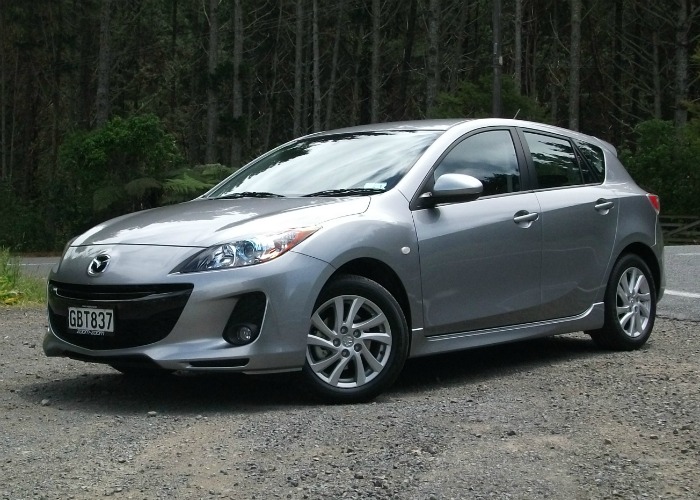
Car reviews
Read our expert car reviews - where we give insight into the latest vehicles to hit our roads.
05 December 2011
New Zealand’s most popular private-buyer compact car just got even more appealing with the addition of a fuel-miser model to the 2012 face-lifted range.

If there’s one thing other than saving the planet that green technology has done for the motor industry, it is providing us with catchy clean and green sounding names such as BlueMotion, ECOnetic, BlueEfficiency and EfficientDynamics among others, and Mazda now gives us another with the introduction of SKYACTIV.
Taking the view that the way forward to achieving the “Zoom Zoom Vision” of achieving a 30% improvement in fuel efficiency by 2015 in comparison with 2008 levels, Mazda has steered clear of what it refers to as “niche technology that is largely unaffordable with other hidden costs” (ie; hybrids and EV’s) and concentrated on refining the combustion process for conventional petrol and diesel engines.
The result is the new SKYACTIV range of Mazda engines, the 1.3 litre version of which has recently received the “Technology of the Year” award by Automotive Researchers and Journalists Conference in Japan.
In time we will see SKYACTIV-G (gasoline) and SKYACTIV-D (diesel) engines of various capacities across the range, but for the time being Mazda New Zealand says it is focusing on the segment where the action is; the compact car segment where the Mazda3 is the darling of private buyers. Accounting for 43% of Mazda’s local passenger car volume, the Mazda3 is second overall in the segment to the Toyota Corolla, a favourite with rental car companies, which accounted for 46% of Corolla’s 2010 sales volume.
The new 2.0 litre 113kW/194Nm SKYACTIV petrol engine delivers a 6.6% improvement in torque, a 4.4% increase in power and a whopping 25% improvement in fuel economy at 6.2L/100km.
The engine has been redesigned leaving no stone unturned. Electrically operated Sequential Valve Timing (S-TV) on the inlet side, reductions in weight and friction, revisions to the shape of the water jacket to reduce cooling system water flow resistance, fuel injectors with 6 holes for improved atomisation of fuel, a raised piston crown with a cavity optimises combustion and suppresses knocking.
For our market, Mazda has opted for a version of the engine that runs on 91 octane fuel but other markets offer a more potent derivative that needs a minimum of 95 octane juice. Even our low octane version runs a pretty high compression ratio of 12.1:1, but the 95 octane version runs a massive 14.1:1 ratio – almost up there with diesel engines.
The rationale for taking the lower compression version is that many consumers, companies in particular, favour vehicles that can run on the lower cost fuel.
The i-Stop system, like other Stop/Start systems that shut the engine down when sitting at traffic lights etc, offers something of a unique solution to quickly restarting the engine. In contrast to other systems that require larger capacity starter motors and batteries, Mazda uses a system they call “Combustion + Motor Assist” which primes the cylinders, firing up the engine using combustion in just 0.35 seconds.
The transmission, body, chassis and tyres all play their part and Mazda claims the all new SKYACTIV-Drive transmission offers the best features of each of the three types of transmission currently available.
They say the DSG type transmission favoured by European manufacturers, while offering a sporty direct feel, quick changes and good fuel consumption suffers from a jerky feel at creep and is expensive to produce. Then there’s the CVT favoured in Japan. While the CVT is smooth in traffic and offers good fuel consumption under light throttle, it has poor high speed fuel economy and has a disconnected and vague feel. Conventional automatics allow smooth operation but poor fuel economy and a tendency to flare under acceleration.
So Mazda wanted to build the ideal transmission, offering the best features of each. The new SKYACTIV-Drive 6 speed unit uses a very small torque convertor, about half the normal size to get the car moving off. Then a large multi-plate lockup clutch locks up at 5km/h, with the result being a smooth take-off, a more direct and connected feel and better fuel economy.
Mazda claims that on the European test cycle for fuel economy testing, lockup through the cycle is now 89% compared with around 50% previously. The shifts are said to occur quicker too, at around 150 milliseconds and overall, the SKYACTIV-Drive trans is said to offer a 7% better fuel economy than a conventional transmission.
SKYACTIV-body utilises advanced bonding methods, uses lightweight high tensile steels and is said to be 8% lighter and 30% more rigid.
Identifying the SKYACTIV model from the rest of the Mazda3 range, in addition to the blue SKYACTIVE badge, there are plenty of other blue bits too. The engine cover, instrument illumination and even highlights in the headlamps are of a deep sky hue.
The Mazda3 GSE SKYACTIV 5 door hatchback is priced at $37,395 including Mazda’s 3 year/100,000km service plan. Other models in the face-lifted Mazda3 range are priced between $31,695 for the entry-level GLX through to $49,195 for the fire-breathing MPS.
Having set a goal of blending a sporty driving experience and design with strong environmental and safety performance, Mazda says they wanted the SKYACTIV to meet customer needs, not just environmental needs. Offering more power, cleaner design and vastly improved fuel economy, they’ve exceeded their target by some margin.